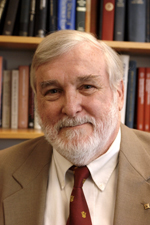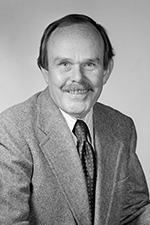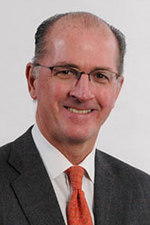Obituaries
Boston University Faculty Members Remembered

William Carey
A College of Engineering professor of mechanical engineering, on July 11, 2012, at 69.
A leading researcher in the field of underwater acoustics, Carey focused on the design and performance of underwater acoustic antennae known as arrays, which have been widely used in tracking enemy submarines and exploring the marine environment.
Also a well-known expert on ocean ambient noise, he conducted extensive studies of noise from breaking waves and the signal-to-noise ratio that towed and other arrays sense in the real ocean environment. In recent years he measured the ambient noise produced by microbubbles and bubble clouds resulting from sea surface activity and helped determine that these clouds can optimally radiate and scatter low-frequency sound.
Ronald A. Roy, ENG chair and professor of mechanical engineering, who worked closely with Carey for more than two decades, describes his colleague as a dedicated educator and consummate leader. “Bill was a completely unique individual who possessed a broad spectrum of knowledge that he readily applied to a host of important scientific and national security problems related to oceanic engineering and underwater acoustics,” says Roy. “He touched many lives over the course of a distinguished career and will be singularly missed by students, friends, and colleagues.”
In 2007 the Acoustical Society of America awarded Carey the Pioneer of Underwater Acoustics Silver Medal for his contributions to understanding ocean ambient noise and defining the limits of acoustic array performance in the ocean. At the time, only 16 other individuals had earned this distinction since the medal was introduced in 1959.
Carey was a member of the Cosmos Club and Sigma Xi; a Fellow of the Acoustical Society of America and the Institute of Electrical and Electronics Engineers; a recipient of the IEEE Oceanic Engineering Society’s Distinguished Technical Achievement, Third Millennium, and Distinguished Service awards; and editor emeritus of the Journal of Oceanic Engineering and an associate editor of the Journal of the Acoustical Society. He was also an adjunct professor of applied mathematics at Rensselaer Polytechnic Institute and an adjunct scientist in applied ocean physics and engineering at the Woods Hole Oceanographic Institution.
Born in Boston in 1943, Carey spent most of his youth in Germany. He attended Catholic University of America, where he earned a bachelor’s degree in mechanical engineering in 1965, a master’s degree in physics in 1968, and a doctorate in 1974. After his doctoral work, from 1974 to 1979, he worked at the Argonne National Laboratory. Over the next three decades he worked for a number of different laboratories and agencies, including the Naval Research Laboratory, the Naval Underwater Systems Center, and the Defense Advanced Research Projects Agency, doing both ocean acoustics research and managerial work. He joined the BU faculty in 1999 after a two-year stint at MIT’s department of ocean engineering. ~Mark Dwortzan

Robert H. Montgomery
A College of Communication professor emeritus of mass communications and public relations, on November 14, 2011, at 90.
Montgomery joined the BU faculty in 1974. He also was a faculty member at Notre Dame College (now closed) and Hesser College, both in Manchester, N.H. Previously, he worked for Anne Weston + Associates and Nashua Corp., both in New Hampshire, as well as Borg-Warner Corporation in Chicago. He was also the owner of the Montgomery Group, a full-service advertising agency.
He earned a bachelor’s degree in English from Baldwin Wallace University and a master’s in marketing communications from Case Western Reserve University. In 1974, he was awarded an honorary doctorate from the Institute of Applied Research in London, England. He retired from BU in 1994.
Montgomery was certified in mechanical engineering and was “a self-proclaimed ‘nut’ of motorcycles and airplanes,” according to the Manchester, N.H., Union Leader.
He spent many years advocating for the elderly. In 2001, he was appointed to the New Hampshire State Committee on Aging by Jeanne Shaheen, who was governor at the time. He received the Senior Advocacy Award in 2005 and was honored as a Senior Hero by the Manchester Region Area Committee on Aging in 2011. ~Maddie Rosenberger (COM’14)

Peter Morrissey
A College of Communication associate professor of public relations, on August 3, 2012, at 59.
After undergoing surgery for brain cancer, Morrissey insisted that disease not derail his life. Although the operation left his vision occasionally impaired, he went jogging and once tripped over an object that blindsided him, gashing his knee. As colleague Stephen Quigley, a College of Communication associate professor, recalls the story, “A passing driver saw Peter sprawled on the side of the road bleeding and stopped to help.” Morrissey assured the driver, “Everything’s fine. You should see the other guy.”
Morrissey kept his pluck even in his last week, when he told his wife that he “had had a great life,” COM Dean Thomas Fiedler (COM’71) says. “Even after he received his diagnosis last year, his comment to her was, ‘How lucky we have been.’”
An associate professor of public relations, Morrissey (COM’87) amassed professional accomplishments, but it was the intellect and personality behind them that most impressed friends and family before he died, leaving his wife and three children. Facing an impending death that medicine couldn’t avert, he fought back with the only weapons left to him: humor and a gratitude for the accumulated blessings of almost six decades. In his life’s finale, the teacher found a teachable moment, his last lesson a luminous, outside-the-class moral he’d urged on corporate clients: meet catastrophe with honesty and grace.
Before joining COM’s full-time faculty in 2006, Morrissey was a public relations executive advising blue-chip companies on big-league matters. In 1999, he started his own firm, Morrissey & Co., providing media relations, reputation management, and crisis communications for clients worldwide. It was the third start-up in a career counseling the likes of IBM, Miller Brewing Co., and Johnson & Johnson, the latter during the infamous 1982 Tylenol murders. An anonymous killer, never found, poisoned seven people with tainted Tylenol capsules in a case that became a model of corporate candor during crisis. PRWeek magazine named Morrissey one of the country’s leading communication counselors in 2004, a man “who should be on the speed dial in a crisis.”
The Tylenol episode demonstrated his approach to his job. Aimee Charest (COM’06), his assistant at Morrissey & Co., says he had three suggested criteria before speaking: “‘Is it necessary I say it? Is what I say the truth, and lastly, is what I’m about to say kind? Try to meet at least two of the criteria—all three if possible.’ Peter had no problem meeting these criteria.”
About a month before his death, Morrissey sent a card to colleague Edward Downes, a COM associate professor. “He referenced Ignatius of Loyola, talked about the ‘bliss of life,’ acknowledged his wife and kids, and never came within a million miles of complaining. Just gratitude—class, really—was what he shared,” says Downes. “He could reference the classic philosophers in the same sentence in which he referenced new media’s influence on public relations. But more admirable was his social intelligence. He could read people well.”
Or teach them to read others. Fiedler recalls his first encounter with Morrissey, shortly after he was appointed dean four years ago. Morrissey had deployed his class on COM’s lawn, lining up pairs of students, each standing in front of a partner, and instructing those in front to collapse backwards, relying on their partner to catch them. “Peter told me that it was an exercise designed to teach the importance of trust among team members, something he said would be critically important to their success in later careers.
“He epitomized the COM model of practitioner-scholar, the person who not only maintains a successful career as a communication professional, but brings that knowledge into the classroom.”
Fiedler says that Morrissey’s wife, Carey, told him that nothing gave Morrissey “greater pleasure…than talking with students, or hearing back from graduates that his classes had been major influences on their careers.”
Morrissey’s career before he arrived at the University “blended splendidly not only with the practitioner accomplishments of some of his BU public relations faculty colleagues, but also with those of us from the more scholarly side of the academy,” says Donald K. Wright, Harold Burson Chair of COM’s mass communication, advertising, and public relations department. “He was a prolific reader…and he was a real class act.”
As a board member of the Boston Athletic Association, Morrissey helped oversee the BAA’s main event, the Boston Marathon, which he also ran several times, according to Fiedler. He was also a member and former chair of Morgan Memorial Goodwill Industries in Boston.
~Rich Barlow
Post Your Comment